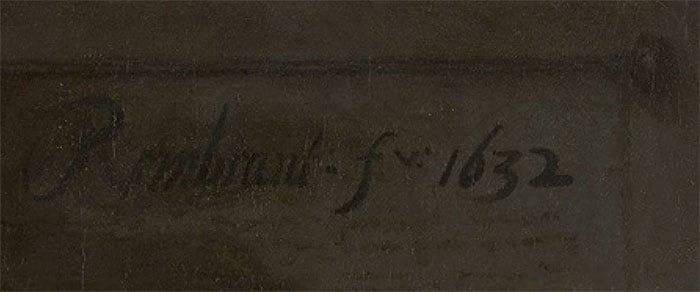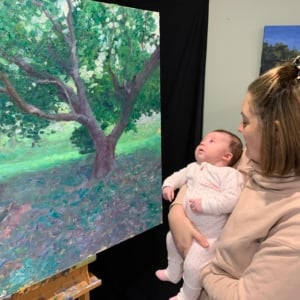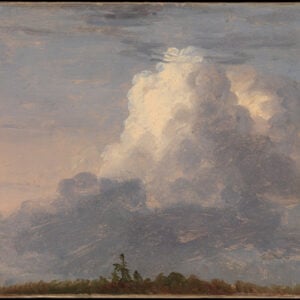In this post, I take a closer look at The Anatomy Lesson of Dr. Nicolaes Tulp by Rembrandt. This is a masterful demonstration of composition and accuracy. It is also a change from the colorful impressionist landscapes which I seem to favor. In this post, I cover:
- Key Facts About the Painting
- Lines of Vision (Implied Lines)
- Use of Color
- Use of Value
- Rule of Thirds in Action
- Key Takeaways
- Want to Learn More?
- Thanks for Reading!

Key Facts About the Painting
- Rembrandt painted it in 1632 at the age of just 26. It was one of his earliest masterpieces.
- The painting features Dr. Tulp delivering a lecture to seven other medical professionals about human anatomy. The corpse is thought to be Aris Kindt, a convicted criminal who was sentenced to death.
- During the 17th century, public dissections were a social event, hence the social attire of people in the painting.
- The people featured in the painting most likely paid to be there. This would explain the meticulous attention to detail Rembrandt gave to each of the figures.
- Some art historians believe two of the figures in the painting were added at a later date (those figures are indicated below).

- If you look closely, you will notice that the corpse’s navel is actually in the shape of an R. Rembrandt was constantly experimenting and changing the way he signed paintings.

- Rembrandt also signed the painting in the top left corner with “Rembrandt, 1632“. Some art historians suggest this is the first time Rembrandt signed with his forename, rather than monograms such as “R”, “RH” and “RHL”.

Lines of Vision (Implied Lines)
The people in the painting are gazing in various directions: some are looking at the book in the corner, some down at the corpse and some at Dr. Tulp, who is looking back at the group.
This creates an interesting array of implied lines, which are basically lines that do not physically exist but are implied or suggested by other means. A line of vision does not physically exist, but it makes us want to look where that person is looking. I have indicated the direction of the implied lines below.
Notice how everyone is generally looking in the same direction, except for Dr. Tulp, who is looking firmly back at the onlooking group. This creates a powerful statement in the painting, as is the case whenever you break up a pattern or rhythm. The implied line created by Dr. Tulp’s vision also helps contain your attention on the people (think about where you would look if Dr. Tulp did not exist in the painting).
Also, observe the unique and personal expression of each person’s face. I can see looks of confusion, confidence, concern and interest. That is the most remarkable aspect of the painting in my opinion. It is hard enough to capture the likeness and emotion of one person, let alone eight.

Use of Color
Rembrandt did not use many colors in this painting. Soft, pastel colors are used in the lights, with the most saturated colors being the reds and oranges used for the corpse’s arm. Deep grays and blacks are used for the darks.
The corpse is painted with some color, but noticeably less than the pastel colors used for the faces of the onlooking people. This suggests the man has passed, but perhaps not all that long ago.
Below is a close-up that demonstrates Rembrandt’s masterful control and subtle color gradations, particularly in the lights. The detail seems to get lost in the deep darks.

Use of Value
Instead of creating interest with color, Rembrandt relied more on value contrast (contrast between light and dark). This was common for artists around this time and is often referred to as chiaroscuro.
Below is the painting in grayscale so you can clearly see all the values. Notice how clear and realistic the painting is even without color.
Tip: If you want to make your paintings appear realistic, then make sure you get your values correct. You can always check your values by grayscaling a photo of your painting.

The grayscale image of the painting reveals an oval area which seems to be illuminated. There is a subtle gradation from dark to light as you go from the outskirts to the people around the center. It is almost as if there is a spotlight on this area. This really focuses your attention on the people.

Rule of Thirds in Action
If I place a three-by-three grid over the painting, notice how key features or focal points are positioned around three of the intersections. The grid intersections are considered to be aesthetically pleasing points in composition, based on what is known as the rule of thirds.

Key Takeaways
Here are some of the key takeaways from this painting:
- Even the great Rembrandt struggled with his signature, so don’t worry if you are as well.
- A line of vision can act as a powerful implied line which you can use to direct people throughout your painting. You can also use implied lines to help contain attention within a certain area.
- You can make powerful statements in your painting by developing a pattern or flow, then breaking it. Rembrandt did that in this painting: everyone is generally looking in one direction whilst Dr. Tulp looks firmly in the other direction.
- Highly saturated or vivid colors are not essential for painting a masterpiece. There are no vivid colors in this painting by Rembrandt.
- You can use value contrast to focus attention on a certain area. In Rembrandt’s painting, it almost appears like there is a spotlight illuminating the people.
- You can use the rule of thirds to help with your composition. Just be careful that you do not pigeonhole yourself into painting your focal points in the same area over and over again.
Want to Learn More?
You might be interested in my Painting Academy course. I’ll walk you through the time-tested fundamentals of painting. It’s perfect for absolute beginner to intermediate painters.
Thanks for Reading!
I appreciate you taking the time to read this post and I hope you found it helpful. Feel free to share it with friends.
Happy painting!
Dan Scott

Draw Paint Academy







whew! that is quite some tutorial. quite amazing how the rule of this works. I was going over this with two ladies yesterday and saying what an amazing concept it was. JM
Great observation I enjoy the revelations while reafingvthis masterpiece. So many details to absorb and use to create a better painting
Thank you so much for this lesson!! I learned a lot. I paint mostly abstract and was thinking about how lines of vision, rule of thirds, etc. would translate to that. I am going to try to take these lessons and apply them in a painting I will start today. Im excited!!
This is extremely interesting information. Thank you.
I was just beginning to get into painting first with water colours, then tempera, then acrylics.
I had a stroke and have been recovering for 2 1/2 years. My dominant (right) side is without sensation, and has limited uncontrolled mobility.
I want very much to try painting with my left hand. I know my style will change dramatically.
I need another couple of months then I would like to join your Academy.
If this is an indication of what you teach, and how you present the information I believe I could learn a lot from you.
Thank you so much. I feel encouraged.
These lessons are simply sensational! Always something new to study and apply. Thank you. You make my morning and illuminate my day.
Thank you again for sharing your very detailed and insightful understanding of painting. I surely will try to incorporate your suggestions in my paintings
Again so much of this information shared. I Learn better with seeing things pointed out . I really enjoy this part of your emails
Dan, I look forward to all of your emails. I learn from and enjoy all of them – it is obvious you put much work into these.
Thank you!
pam
Analysis is a wonderful and insightful tool. It should be done MORE routinely. There is so much to learn from the Masters and each other. Thank you.
Bill Chesser
I have just started painting. It is beyond me how anyone can capture that much detail almost down to single hairs. How in the world?
Thankyou for making it all make sense!
Enjoying your blogs and look forward to them. Thank you!
It is so nice to come in from working a goat and cattle farm to read what you take the time to prepare for us. It is a mini vacation for me and right now it is 11pm. I do need to go feed the dog now and then to bed to get up at 7 and start my day. But once again your time is truely appreciated.
I downloaded pictures from your library but when moving last year and not painting for a few months I can’t find them. Is there any way you could help
Hi Bonnie. I will send you an email on this. Thanks! Dan
Very interesting indeed. Thank you again.Dianne.
Nice. I am enjoying your analyses.